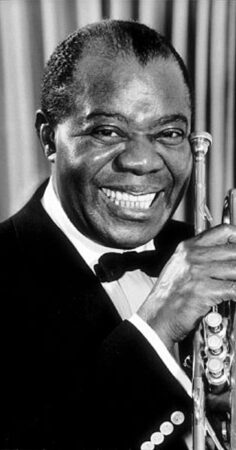 Louis Armstrong, also known as “Satchmo,” was one of the most influential American musicians in history. He was a civil rights pioneer who broke down numerous racial barriers. Widely known for popular songs such as “What A Wonderful World,” “Star Dust,” and “Hello, Dolly,” he was also one of the first to transform jazz from an ensemble performance to a soloist’s art.
Louis Armstrong, also known as “Satchmo,” was one of the most influential American musicians in history. He was a civil rights pioneer who broke down numerous racial barriers. Widely known for popular songs such as “What A Wonderful World,” “Star Dust,” and “Hello, Dolly,” he was also one of the first to transform jazz from an ensemble performance to a soloist’s art.
Armstrong was born on August 4, 1901. Growing up in harsh poverty in New Orleans, he lived mostly with his maternal grandmother in a neighborhood so rough it was nicknamed “The Battlefield.” Armstrong dropped out of school in the fifth grade so that he could work, and in 1912, on New Year’s Day, he shot his stepfather’s gun in the middle of the street, after which he was sent to the Colored Waifs Home as a juvenile.
At the Waifs Home, Armstrong became the leader of the Waifs Home Brass Band. When he was released in 1914, he set his sights on becoming a professional musician and was mentored by one of his city’s top cornetists, Joe “King” Oliver. Armstrong would eventually replace Oliver in Kid Ory’s Band. In 1924, Armstrong played with the Fletcher Henderson Orchestra in New York for a year before returning to Chicago to focus on his solo career. It was there that he created some of his most notable works with a band under his own name, “Louis Armstrong & His Hot Five,” which later became “Hot Seven.” By 1929, he was widely known, and he continued to tour as a solo artist accompanied by large orchestras around America and Europe for many years.
In 1935, Armstrong hired a new manager by the name of Joe Glazer. Glazer would remain Armstrong’s manager for the rest of his life, hiring Armstrong’s bands, setting up recording deals with Decca, and guiding his film career and radio appearances. “Satchmo” often came across as good-humored to the public, but in 1947, he played a rare dramatic role in the film “New Orleans.” Performing with a Dixieland band in the film inspired the formation of Armstrong’s All Stars, with whom he continued to tour for the rest of his career.
The years of non-stop touring eventually took a toll on Armstrong’s health. He had his first heart attack in 1959, later returning to the hospital in 1968 for kidney and liver issues. Doctors encouraged him not to continue with his grueling schedule, but he couldn’t stay away from the stage. He returned to performing in 1970, but his health again took a turn and Armstrong passed away at his home in Queens, New York on July 6, 1971.
Louis Armstrong was a bandleader, singer, soloist, film star, and comedian, and he had an almost unmatched impact on jazz and popular music. His timeless hits are favorites of many of our listeners and are considered staples of the Life 103.1 music library.
(biography.com, grunge.com, louisarmstronghouse.org, britannica.com)